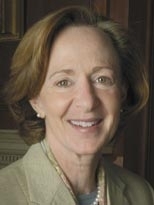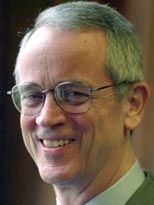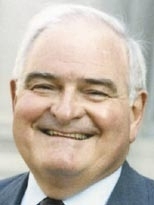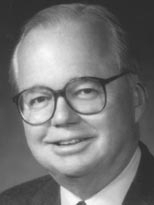When Susan Hockfield is inaugurated on Friday, May 6, she will officially take her place among the respected leaders who have guided the Institute over the years, including the three living former MIT presidents, Charles M. Vest, Paul E. Gray and Howard W. Johnson.
Susan Hockfield, president from 2004 to present
Susan Hockfield, a noted neuroscientist and former provost of Yale University, is the first life scientist to lead MIT. She joined the Yale faculty in 1985 and was named full professor in 1994. Hockfield was dean of Yale's Graduate School of Arts and Sciences (1998-2002) before becoming provost. She became MIT's 16th president on Dec. 6, 2004.
As graduate school dean, Hockfield revitalized the administration of the school and addressed longstanding problems in academic, extracurricular and financial support for students. As provost, she advanced Yale's major initiatives in science, medicine and engineering, including a $500 million investment in facilities. She also encouraged collaborative work among the sciences, humanities and social sciences throughout the university.
Hockfield's research has focused on the development of the mammalian brain and on glioma, a deadly form of brain cancer. At Yale, she was the William Edward Gilbert Professor of Neurobiology; she now holds an MIT faculty appointment as professor of neuroscience in the Department of Brain and Cognitive Sciences.
Hockfield earned her undergraduate degree from the University of Rochester and the Ph.D. from the Georgetown University School of Medicine. She now lives in Cambridge with her husband, Thomas N. Byrne, M.D., and their daughter, Elizabeth.
Charles M. Vest, president from 1990 to 2004
Charles M. Vest, 64, is the second-longest-serving president in MIT's history. Vest oversaw initiatives in new methodologies for education such as OpenCourseWare, several new degree programs and a flurry of major campus construction projects.
One of Vest's key achievements was focusing broader public attention on issues of education and research policy. He chaired the President's Advisory Committee on the Redesign of the Space Station and the U.S. Department of Energy Task Force on the Future of Science Programs as well as the Association of American Universities. He continues to serve on the President's Council of Advisors on Science and Technology and recently finished work on the Commission on the Intelligence Capabilities of the United States Regarding Weapons of Mass Destruction. His 2004 book, "Pursuing the Endless Frontier: Essays on MIT and the Role of Research Universities," explores significant issues facing academic institutions.
Vest remains at the Institute as a faculty member in mechanical engineering (on sabbatical in 2005) and has accepted invitations for visiting lectureships at several universities here and abroad.
Paul E. Gray, president from 1980 to 1990
Paul E. Gray, 73, has been at MIT almost continously for more than half a century. He earned bachelor's, master's and doctoral degrees in electrical engineering starting in 1954 and then rose through the faculty ranks to become professor in 1967. Gray held several administrative roles ranging from associate dean to chancellor before becoming MIT's 14th president.
Among the programs Gray helped establish are the Undergraduate Research Opportunities Program and the Leaders for Manufacturing Program. He encouraged undergraduate curriculum reforms in the 1980s that strengthened the humanities, social sciences and biology. Gray was committed to increasing opportunities for minorities and played a key role in establishing MIT's annual Dr. Martin Luther King Celebration.
After stepping down as president, Gray served as chair of the Corporation from 1990 to 1997 and then returned to his role as professor of electrical engineering, a post he still holds.
Howard W. Johnson, president from 1966 to 1971
Howard W. Johnson, 82, became president of MIT after serving seven years as professor and dean of the Sloan School of Management. At the helm during the height of the political and social ferment of the late 1960s, he gained respect for listening to all sides and for combining progressive views on issues such as Vietnam and the environment with expertise in management. Johnson described those times in his book, "Holding the Center: Memoirs of a Life in Higher Education (MIT Press, 2001).
Johnson oversaw such major initiatives as the opening of several new residence halls (Eastgate in 1967, Random Hall and the east wing of McCormick Hall in 1968 and MacGregor House in 1970). MIT faculty members also received Nobel Prizes in three consecutive years during his tenure: Har Gobind Khorana in 1968, Salvador E. Luria in 1969 and Paul A. Samuelson in 1970.
Johnson served as chair of the MIT Corporation from 1971 to 1983 and has also served on numerous governmental panels and as a trustee or director of such institutions as the Federal Reserve Bank of Boston, Radcliffe College, the Museum of Fine Arts and the Boston Symphony Orchestra. He has been a Corporation Life Member Emeritus since 1997.
A version of this article appeared in MIT Tech Talk on April 27, 2005 (download PDF).









